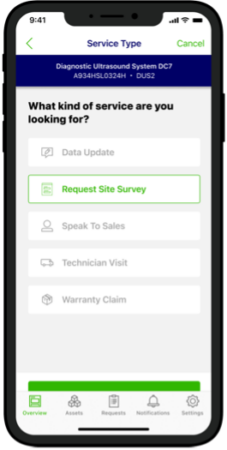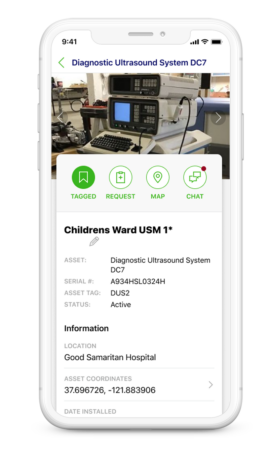The newest addition to the ServiceMax family is ServiceMax Engage, a turnkey mobile app that connects service organizations with their end customers to improve customer experience and asset data quality.
Since its launch, Engage has seen impressive adoption by manufacturers across industries. In celebration of the one-year anniversary of Engage, we are taking a look back at why we created Engage and the use cases it addresses.
The Forgotten Persona
Back in 2020, we spent time talking to our customers and evaluating how to better support them. We quickly noticed that there was a huge chunk of the market being neglected by nearly everyone, and that was the end customer—the people that own and operate the machines.
And as we delved deeper into this idea, we realized that if we could provide a targeted experience for end customers that linked to all of our products including ServiceMax Go and Service Board, and we could provide a better overall experience.
Over the years, many companies have tried serving their clientele with customer portals, but these tend to serve a fixed scope of use cases and lack a true mobile experience. With this in mind, we zeroed in on the use cases that are relevant to a mobile user versus what is more suited for a desktop experience.
We took inspiration from the consumer world, specifically banking, where end customers use a company’s mobile app for quick transactions and handy features like Face ID, as well as the website for more involved activities like applying for a mortgage.
[Watch Now: Engage User Journey Video]
Choosing Mobile-First
As we continued to tease out the concept for Engage, it became apparent that in our mobile-first world, end users would greatly benefit from having a user-friendly, dedicated mobile experience. At the same time, service providers would also benefit from having a product that works right out of the box with targeted flows and experiences and completes their omnichannel strategy.
With customer portals, they can be quite a big lift to build, maintain and add new features to. According to the annual CHAOS report, 66% of technology projects end in partial or total failure. On top of this, portal development is often put on IT’s plate, where getting the project completed as quickly as possible is the priority, rather than addressing the business case. For many businesses, this results in a bare-bones portal that allows customers to create a case, which they could just as easily do by sending an email.
By being able to purchase a packaged app rather than having to start a lengthy development project, the business case stays front and center. That said, we see Engage and customer portals working together in the same way that banking apps and desktop experiences work together. Engage offers a quick and easy way to create cases, request service visits, update asset data, fix minor issues, and receive remote support via chat. It empowers users with the same asset and service data that technicians have access to and provides real-time notifications and updates. Engage complements existing customer portals by dynamically linking to pages in your portal or corporate site to perform more involved transactions such as the purchase of new products and service contracts.

Another benefit to having both experiences is the leeway it gives the service organization during portal development. One customer that was originally planning a portal project found that with Engage, they could deploy something of value right away and focus on a longer-term, smaller-scoped portal project to follow.
As this kind of interaction with their customers was new to them, they held a pilot of Engage with a small subset of customers. With very little setup time, they were able to quickly validate the value directly with their customers, who all overwhelmingly—and not surprisingly—supported the mobile-first approach.
Solving the Asset Data Quality Problem
The final piece that we wanted Engage to address was asset data quality. Capturing equipment data is so critical for service organizations and they often have to deal with inaccurate, out-of-date data.
Bad data can impact your technicians’ productivity and efficiency when they’re on-site, such as if they don’t have the correct location, the right parts, or don’t know about service history. In a worst-case scenario, a return visit is required. Bad data can mean that it’s difficult to determine the profitability of your contracts and the cost to serve. Bad data can also mean that you have equipment lying around with expired warranties that you don’t know about. That is equipment that you could attach new contracts to, which drives predictable recurring revenue and growth, rather than the peaks and troughs that come with traditional break fixes.
 In Engage, we surface asset data to end customers so that they can flag inaccuracies. Oftentimes, data quality is such a monster of a problem that companies don’t know where to start. Engage provides that standard channel for improving data quality one day at a time.
In Engage, we surface asset data to end customers so that they can flag inaccuracies. Oftentimes, data quality is such a monster of a problem that companies don’t know where to start. Engage provides that standard channel for improving data quality one day at a time.
One of our recent Engage customers had a problem with not speaking the same service language as their customers. This caused confusion as the service org would refer to an asset by the serial number, for example, but the customer would refer to it by the asset tag number.
With Engage, the company was able to expose the fields that caused confusion and have their customers fill in the information so they could start speaking the same language.
As we enter Engage’s second year, we are excited to launch new features that continue to improve the customer experience and asset data quality. Stay tuned for my next article that dives into the current functionality and what we have planned for 2022.


Share this: